unit2教案示例
- 格式:ppt
- 大小:43.00 KB
- 文档页数:4
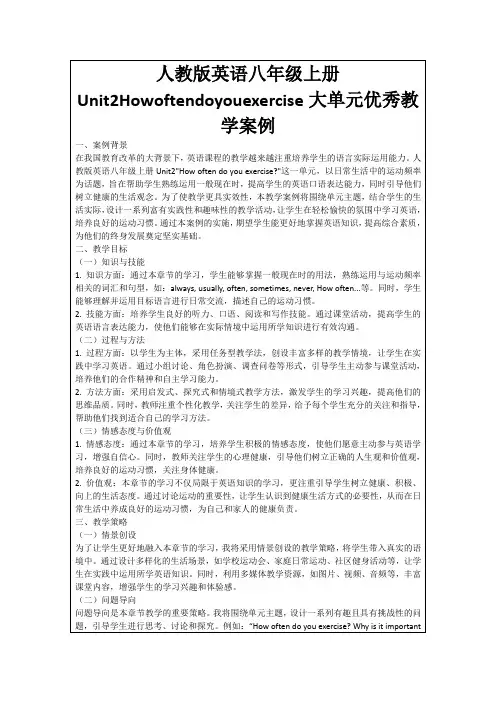
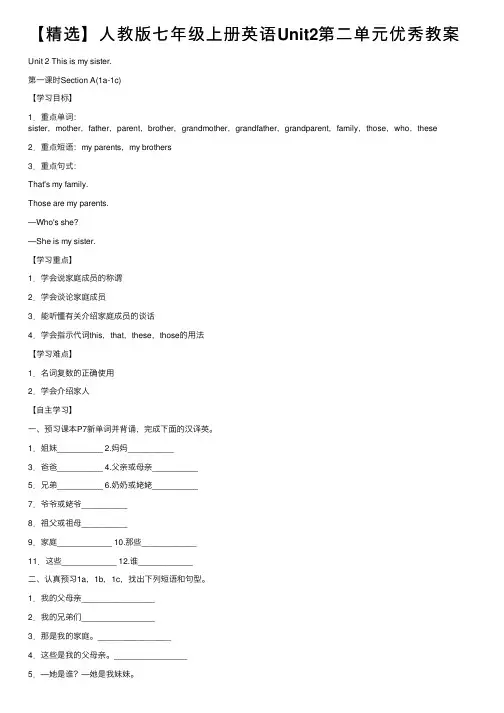
【精选】⼈教版七年级上册英语Unit2第⼆单元优秀教案Unit 2 This is my sister.第⼀课时Section A(1a-1c)【学习⽬标】1.重点单词:sister,mother,father,parent,brother,grandmother,grandfather,grandparent,family,those,who,these 2.重点短语:my parents,my brothers3.重点句式:That's my family.Those are my parents.—Who's she?—She is my sister.【学习重点】1.学会说家庭成员的称谓2.学会谈论家庭成员3.能听懂有关介绍家庭成员的谈话4.学会指⽰代词this,that,these,those的⽤法【学习难点】1.名词复数的正确使⽤2.学会介绍家⼈【⾃主学习】⼀、预习课本P7新单词并背诵,完成下⾯的汉译英。
1.姐妹__________ 2.妈妈__________3.爸爸__________ 4.⽗亲或母亲__________5.兄弟__________ 6.奶奶或姥姥__________7.爷爷或姥爷__________8.祖⽗或祖母__________9.家庭____________ 10.那些____________11.这些____________ 12.谁____________⼆、认真预习1a,1b,1c,找出下列短语和句型。
1.我的⽗母亲________________2.我的兄弟们________________3.那是我的家庭。
________________4.这些是我的⽗母亲。
________________5.—她是谁?—她是我妹妹。
_________________________________________________________________ 【课堂导学】Step 1情景导⼊Teacher:This is my family photo,and these are my family members.This is my father,and that is my mother.These are my grandparents.Can you introduce your family members to us?If you can't,don't worry.We will learn it this lesson.环节说明:由家庭照⽚引出本节课的重点——介绍家庭成员,激起了学⽣的学习兴趣,新课导⼊简单明了,过渡⾃然。
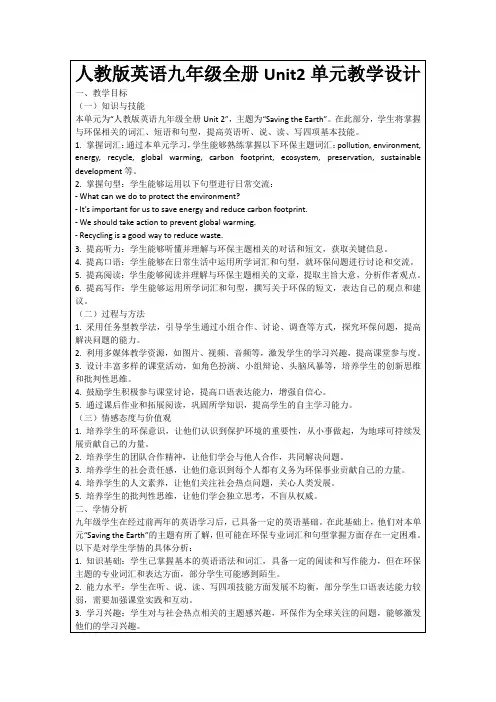
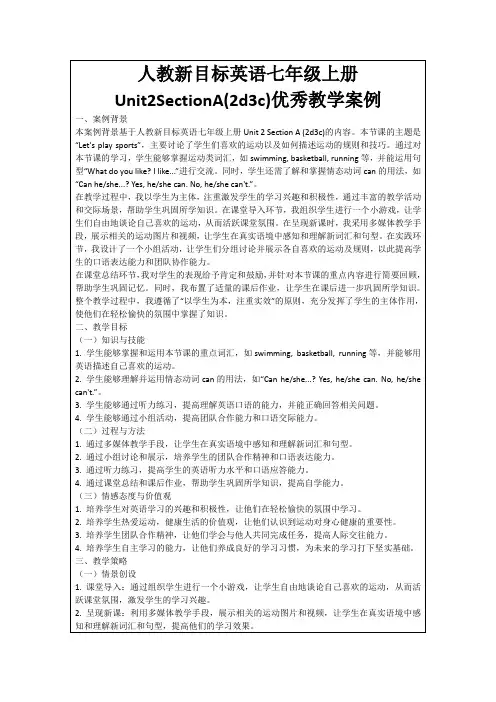

《Unit2KeepingHealthy》全单元教案Unit 2 Keeping HealthyTopic 1 How are you feeling today?Section ATeaching aims and demands:1Understand the dialog about seeing a doctor.2Learn how to express feelings and pains.3Learn how to give advice to others.Teaching procedure:Step 1 ReviewGreeting to each other. The teacher and students ask each other some questions. (chain questions)For example:Teacher: How are you?Student 1: Fine, thank you, and you?(to Student 2)Student 2: I’m fine, too. (to Student 3:) How about you?Student 3: I’m fine, thanks, and you?(to Student 4)Student 4: I’m very well. (to Student 5:) How do you feel today?Student 5: I feel very well.Teacher: Why?St udent 5: Because it’s a fine day today.Step 2 Presentation1.After the questions. The teacher summarizes the feelings:We re all very well today.We feel very happy.But how does Betty feel, do you know?Then the teacher shows a picture of Betty, and helps students answer.Play the recorder, and let students find the answers according to the listening:(1a) 2.Show some more pictures,or reading passage 2, then ask and answer: Whats the matter with him?At last, the teacher writes the key words on the blackboard and explain the new words Step 3 ConsolidationThe teacher acts as if he has a headache. Let students guess: What’s the matter with me?You have a headache.Ask the students for some advice:If I have a ..., what should I do?Then finish the exercises in 3a.Step 4 Practice1. Make a conversation in pairs.Finish 1b and 3b.For example:One student acts as if he has a toothache,another student ask him some questions. Let them make dialogs.2. Finish 4. Play the tape recorder.Let students find the correct picture and check the answer. Then play again. Let the students follow the readingStep 5 ProjectThe teacher gives the students some notes which have the phrases on them: have a headache, have a stomachache, have a toothache and so on. Let the students who gets the note act as if he has a headache. Let the other students guess and give a quick answer. Then give some advice on it.Section BTeaching aims and demands:1Go on talking about seeing a doctor.2Understand the dialogs about seeing a doctor.3Review how to give advice.Teaching procedure:Step 1 ReviewShow the pictures in last period. Let students give a quick answer. (chain questions)Teacher: What s the matter with him?Student 1:He has a toothache.Teacher: What should he do?Student 2:He should see a dentist.Change to another picture and go on with the question.Step 2 Presentation1. After showing the pictures in las t period. Show a new picture, which shows the conversation between Bruce and Mr.Lee. (or let the students have a look at 1.) Ask these questions: How does Bruce look?How does Bruce feel?Help students answer:Bruce looks pale!He doesn t feel very well!2. Play the tape recorder. Let students complete the dialog according to the listening:Mr.Lee: Hey, Bruce. You pale. What’s ?Bruce: Well. I have a and a .Mr.Lee: I’m to hear that. you have the .Bruce: DW〗Oh, I’m terrible.Mr.Lee:You’d better go to see a . Shall I you the ?Bruce: No, thank you! I’ll some medicine and see how it .Then let the students open their books, read the dialog in 1 and check th eir answers.The teacher explain the new words and language points:pale, maybe, terrible, medicineYou look pale!Shall I ...... see how it goes.Step 3 ConsolidationLet students finish 2. Make a competition. Let’s see who is the first to finish the dialog, then listen and check the answer.Make sure that the students can read the dialog correctly. Then act it out. Step 4 Practice1. Do 3. First Match the sentences. Then make up a dialog in pairs.2. Do 4.Listen and fill in the blanks. Then listen again and check the answers.Step 5 ProjectSuppose Xiao Qiang has something wrong when he is at school.(Students may have different ideas about the illnesses.) Xiao Qiang talks to Mr.Wang at Mr.Wang’soffice. Make up a dialog between Xiao Qiang and Mr.Wang. Finish the dialog during 3 to 5 minutes. And then perform in front of the class.Section CTeaching aims and demands:1Learn to Listen to some materials and get information.2Learn to use what we learned.3Learn to ask for and give advice.Teaching procedure:Step 1 ReviewGreeting each other. Play the guessing game. The teacher act out different illness es. Let students guess what it is. Ask andanswer: What’s wrong with me? You have a headache/a stomachache.What should I do?You should ...You’d better ...Step 2 PresentationThe teacher act as if his leg hurts. Then tell students: My leg hurts.Explain the new word “hurt” and ask:What happened to me? Guess!Then lead into:I had an accident, and I hurt my leg. Someone had an accident, too. Please listen to the story.Play the tape recorder,then finish 1a and 1b.After listening to the story. Let students describe the pictures according to the tape.Play again, and let students answer the questions 1b. Then check their answers.Explain the use of “hurt”Step 3 Consolidation1. The teacher asks: What should Michael do?Let the students answer first. Then listen to the dialog 2a. And finish 2b.take some medicine.Michael should stay in bed.eat a lot of fruit and drink plenty of water.Michael shouldn t move his leg too much.2. Play the tape again. Let students follow and imitate, then check their answers according to the dialog:1. F 2. F3. FStep 4 Pra ctice1. Pair work: Suppose one is a doctor, the other is a patient. Make up a dialog and act it out.2. Chain story: The teacher may give the beginning. Let the students continue with the story one by one.For example:Teacher: Yesterday Xiao Ming played basketball with his friends.Student A: Suddenly he fell down and hurt his left arm.Student B:...Step 5 ProjectHave a competition: Divide the class into groups. Each group begins a storyfrom the first student to the last. One sentence each. At last, let’s see which group has the best story in the shortest time.Section DTeaching aims and demands:1Sum up the sentence patterns and useful expressions in Topic 1.2Improve listening and speaking skills to writing skills.3Lead up suggestion voice to other topic.Teaching procedure:Step 1 ReviewAsk some questions about what they learned in the last perio d.Who had an accident?What was wrong with him?Who went to call a taxi?What was Dr.Jiang s advice to Michael?Who came to visit Michael in hospital?Let students retell the story of Michael according to thesequestions. Step 2 Presentation1. The teacher shows a letter and tell: This is a letter from Peter to Lily. But it’s not completed. Let’s help Peter to complete this letter.Let students finish 1a then read the passage loudly.Notes: 1) not... until...2) worry about ...2. The teacher asks some questions about the passage:1) Why can t Peter read the books?2) What was wrong with Peter?3) How did Peter get sick?4) How was Peter’s sister?While students are answering these questions, the teacher writes some key words on the blackboard.couldn t —until —had —weekend —a sore throat —a toothache — Friday —football — flu — sister — sick — coughed Then let the students retell the story according to the above words.Step 3 ConsolidationDo 1b. First give Peter some advice orally, then let students write down their answers. Ask some students to read their answers, then help them check the answers. Step 4 Practice1. Do 3.Put the sentences into the right blanks. Read the dialog in pairs.2. Divide the class into two groups. Think of some probl ems about health. Ask each other for help. Give some advice to solve the problem. The group which can t solve the problem will lose.Step 5 ProjectWork in groups. Four in one group. Each student goes over one section of Topic 1. Summarize the language points. At last,share with each other.Topic 2 Is it good for your health?Section ATeaching aims and demands:1.Learn to talk about the topic of the healthy living habits.2.Learn to use the gerund as the subject.3.Go on practicing how to give advice.Teaching procedure:Step 1 ReviewShow some pictures of Topic 1.Section 1, ask and answer:Teacher:What s wrong with him?Student:He has a headache.Teacher:I think he should/shouldn t...Teacher:What s the trouble with her?Student:She has a cold.Teacher:She had better(not)...Review like this.Step 2 Presentation1Teacher:Kangkang is also feeling terrible today. What s the trouble with him?Play the tape. Let students answer the questions according to listening.2Explain the new words: stay up late, health, tonight. Play again. Let students follow and imitate the reading.(1a) 3Do 1b. Students practice and act it out.Step 3 Consolidation1 Play the tape. Let students do 2.2Play again, let students follow and imitate the reading.Check the answer to “How did Wang Jun get a headache?”Step 4 Practice1Do 3: Pair work.Teacher:If I have a headache, what should I do?Student:You should/shouldn t.../You d better(not)...Then students ask and answer questions like this. (chain questions)2Teacher:Bad habits can cause headache or other illness. So we should have good hadits.Explain “habit”, then write down “habit” and “good/bad”. Students do 4a. 3Teacher:What other habits do you have?Student:I like getting up late.Teacher:Is getting up late good or bad for your health?Students:...Students work in pairs like this, finish 4b:A: Is ... good or bad for your health?B: It s good/bad....Step 5 Project1. Group work: Four students work in one group. Talk about what are healthy habits, and what are unhealthy habits. Try to use these sentences:(4b)—Is going to bed early good or bad for your health?—It’s good.Then choose one student to write down the result. And choose a speaker to give a report to the whole class.For example: We think that going to bed early is good for our health.So we should go to bed early every day.Playing sports after meals is bad for our health.So we shouldn t play sports after meals.Section BTeaching aims and demands:1Go on learning good habits to keep healthy.2Improve from “listen, read” skills to “speak, write” skills step by step.3Master “must” and “must not”.Teaching procedure:Step 1 ReviewGo on with the report on healthy habits. The teacher point out the language points:Doing sth is good/bad for ...You should do ...Step 2 Presentation1. The teacher write some habits on the blackboard.For example: eat breakfastgo out for a walkgo to bed early and get up earlydrink plenty of waterThen the teacher summarize: These are all healthy habits.But do you know why they can help us keep healthy?2. Play the tape recorder. Let the students find out the answers according to listening. (1a) First play once, if the students can not find all the answers. Play again. Then write down the key words for the answers on the blackboard:eat breakfast——gives ... energy ...go out for a walk —— good exercise ... necessary...drink plenty of water ——...good...health.go to bed early and get up early ——... keep...active... daytime.The teacher points out the new words. Make sure that thestudents can read and understand them exactly.Step 3 Consolidation1. Let students retell the passage according to the key words on the blackboard.2. Do 1b, write the vocabularies to finish the sentences.Step 4 Practice1. Do 2a. Let students speak the sentences orally:You must wash hands before meals. You must not read in strong sunlight.2. Then let students write more sentences by using “You must ...” and “You must not ...”.Step 5 Project1. Work in groups. Four students work in one group. Finish 2b. Choose one student to write down the result, and another student to give a report to the whole class.2. The students who has no chance to report should practice more after class and get ready to report in the next period.Section CTeaching aims and demands:1 Improve students’ablities from listen ing, speaking to reading.2Learn to get information from the passage by skimming.3Learn to summerize by scanning.Teaching procedure:Step 1 Review1. Let some students give a report on the project they finished in last period. The teacher points out the important sentences:You must .../You must not...2. Let the students think about the causes of the headache. And try to give some answers.Step 2 Presentation1. Play the tape recorder 1a. Let students tell “True” or “False” a bout these sentences:1)A headache is a disease.2)A headache may show that something in your body is wrong.3)We may have more than one headache each week.4)Headaches can often make you worried.5)You needn t go to see the doctor when you have a headache.The teacher can write down these sentences on flash cards before class, or he can read them after playing the tape.2. Skimming. Let students read the passage quickly and master the main idea. Underline the new words and the teacher explains them.3. Scanning. Read the passage more carefully. Then finish the questions in 1a. Step 3 ConsolidationThe teacher check the students’ answers. Then write some key words of the answers on the blackboard. Let the students retell the passage according to the key words.1)not a disease —— show —— wrong2)a fever —— other illnesses3)may get a headache whenwork —— hardcan t —— enough sleep exercise —— emptyStep 4 PracticeLet the students discuss: How does a body become sick?Then do 2a. Let students tell the ways of becoming sick:1)through the nose2)through the mouth3)through the skinStep 5 Project1. According to the result of Step 4. Let the students find out some ways to stop germs 2b. First speak some sentences orally. Make sure to use “We should .../should not...” and “We must.../must not...”.2. After the oral practice, let each of the students write at least 5 sentences about how to stop germs.Section DTeaching aims an demands:1Go on learn ing what are healthy habits.2Improve the students listening, speaking, reading and writing skills.3Summerize the grammar focus and useful expressions in the topic.Teaching procedure:Step 1 Review1. Let some students report the project in last period. The teacher point outthe language points.2. The teacher asks the students something about healthy habits.For example:—What are healthy habits?—Going to bed early is good for our health.—Doing morning exercises is a healthy habit.Step 2 Presentation1. After talking about healthy habits. The teacher asks something about healthy foods.Show some pictures and put them on the blackboard, and write the names of the foods. Make sure the students can readall of them.2. Let the students divide these foods into groups. finish 1b.3. Let students tell which are healthy foods and which are unhealthy foods.Step 3 Consolidation1. Play the tape recorder 1a. Complete the passage according to the listening.As we know, gives us energy. We must have to keep us . Of course,we must also have the of . We should eat more and andless . A cup of and an a day can help make us . Different help us in different . Too , too or a choice of can makeus .2. Play again. Let the students follow and imitate the reading.Step 4 PracticeLet the students do 3 by themselves. Then give a report to the whole class.Step 5 Project1. Let students go over all the pattern sentences in this topic 2a, 2b. Finishthe writing project 3 by using the sentences they have learned in Topic 2. Each student writes at least 5 sentences.2. Write a short passage which contains 6080 words.Title: How to Keep HealthyInstruction: Try to use the sentences you have learned in Topic 2 as many as possible.Topic 3 We should do our best to fight SARS.Section ATeaching aims and demands:1Talk about how to fight SARS.2Learn how to interview others.3Master the words “should” and “shouldn t”.Teaching procedure:Step 1 ReviewLet the students tell good habits and bad habits. Use these sentences:We should do ...We shouldn t do ...We must do ...We must not do ...We don t have to ...Step 2 Presentation1. First the teacher says to the students “Good habits can help us to keep healthy. But bad habits can cause diseases. In 2003, there was a serious disease called SARS (Severe Acute Respirators Syndrone)”. Then ask them, “what do you know about SARS?”Ask the students to talk about “SARS”.2. Introduce Kangkang s father to the students. Then the students listen to the dialog and answer the questions: —What do you know about SARS according to the listening?—It spreads easily among people.Play again, ask more questions:—What should we do to stop it?—We’d better have a balanced diet and take more exercise.—We must not go to the crowded places.Step 3 Consolidation1. Play the tape recorder, and let students follow the tape and imitate.2. Do 1b, and finish the questions in pairs.Step 4 Practice1. Let students think of more good ideas to stop SARS away from us.2. Do 2, then make up dialogs in pairs.Step 5 Project1. Make an interview: Four in one group. Suppose one of them is a journalist and the others are doctors. He asks questions, the other three answer.2. Every student writes at least three sentences about how to fight SARS.Section BTeaching aims and demands:1Learn how to make a tel ephone call.2Make sure you can take a message of a telephone call.3Make sure you can read the telephone message.Teaching procedure:Step 1 Review1. Let student retell at least three sentences about how to fight SARS.2. Ask and answer about Kankang’s father:What’s Kangkang’s father?Where is he now?Why can t he go home?Step 2 Presentation1. The teacher lead into: Kangkang misses his father very much. What should he do?The students may answer: He should call his father.2. Listen to the dialog 1a and answer questions:1)Can Kangkang’s father answ er the phone? Wh y or why not?2)What is he doing now?3)What does Kangkang tell his father?4)What will Miss Hu do?3. Play the tape again, and finish 1b.Step 3 ConsolidationLet students read 2. Put the sentences in the right order, and make up a new similar dialog.Step 4 Practice1. Read the telephone messages 1b. Complete the dialog according to the information from the messages.2. Listen to the tape. Follow and imitate.Step 5 ProjectSuppose you are calling Xiao Wang. But he’s not in. His mum answers the telephone call. You ask her to give him a message. Tell him to go to the zoo with you at 8∶30 tomorrow morning.Let students make up a dialog in pairs, then act it out.Section CTeaching aims and demands:1Learn how to do the skimming and get information.2Master the simple past tense.Teaching procedure:Step 1 Review1. Ask some questions about SARS:What do you know about SARS?What should we do to stop SARS away from us?2. Let some s tudents introduce something about Kangkang’s father.What do you know about Kangkang’s father?Step 2 Presentation1. Read the passage 1a, let students tell“True” or “False”.1)Kangkang’s father was a patient in Xiaotangshan Hospital.2)Kangkang’s fat her could talk with his family on the phone.3)SARS is a kind of serious disease.2. Read the passage more carefully. Answer the questions 1b. The teacher writes some key words on the blackboard: doctor — SARS — serious — hospital — couldn t — home — talk — phone —missed — duty — saveStep 3 Consolidation1. Using the key words on the blackboard, retell the story in 1a.2. Rewrite the story with your own words,and finish 1b.Step 4 Practice1. Listening practice: Listen to the dia log and finish the chart below:Names How did they spend their time at home? How did they think about it? Kangkang on the Internet.Michael had to and .Jane her mother at home.Maria a lot of stories at home.2. Finish 3b, 3c.Step 5 Project1. Work in groups. Four in one group. Each of the students acts one character: Kangkang, Michael, Jane and Maria. Act out the dialog according to the information in the chart.2.Work in groups. Make a survey and complete the chart below:Names How did you spend your time last Sunday? How did you think about it? 1234Choose one speaker to give a report.3.Finish 3c.Let students make up a passage ab out Kangkang’s father.Section DTeaching aims and remands:1Summerize the grammer focus and useful expressions in topic 3.2Improve the listening, speaking, reading and writing skills.3Go on talking about health.Teaching procedure:Step 1 Review1. Chain questions. Ask the students to answer the following questions quickly: Did you have breakfast this morning?What did you have for breakfast?Where do you usually have lunch?What do you have for lunch?When do you usually have supper?What do you have for supper?What is your favorite food?Which foods are good for your health?2. Ask and answer in pairs3. Then retell the answers to the class.Step 2 Presentation1. Look at the pictures 1. Describe the differences between these two pictures.2. Play the tape recorder. Choose the correct picture.3. Listen to the tape again, then write down the answers in 1. The teacher writes some key words of the answers on the blackboard.Step 3 Consoli dation1. Retell the passage according to the key words.2. Let the students go over the language points in Topic3. Do 2a, 2b.Step 4 PracticeMake a survey to each other. ( Four in one group)Complete the chart below:Names What good habits do you have? What bad habits do you have?1234Choose one speaker to give a report. Give him some advice on how to change his bad habits.Step 5 Project1Discover the information about an illness in 5. If the students can t finish it in class, give them enough time to study and find more information after class.2Using the information in T opic 3, ask the students to write a short passage on how to fight the flu.3Enjoy this song “Auld Lang Syne”。
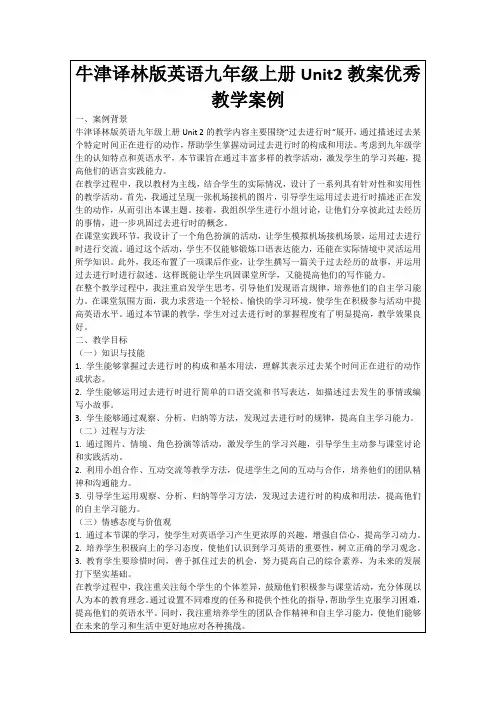
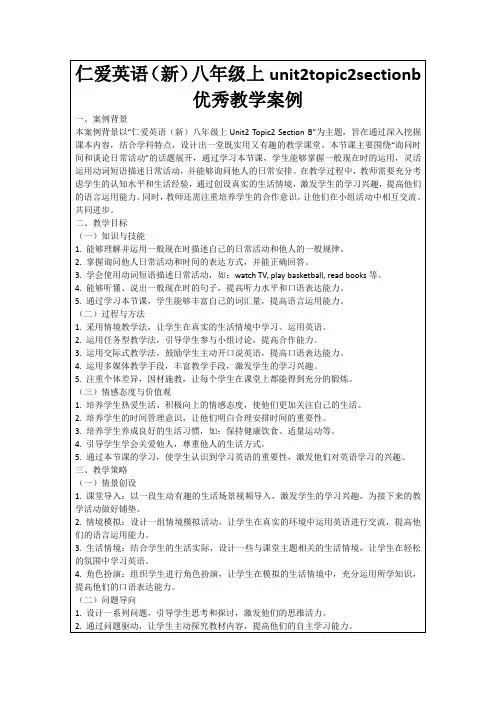
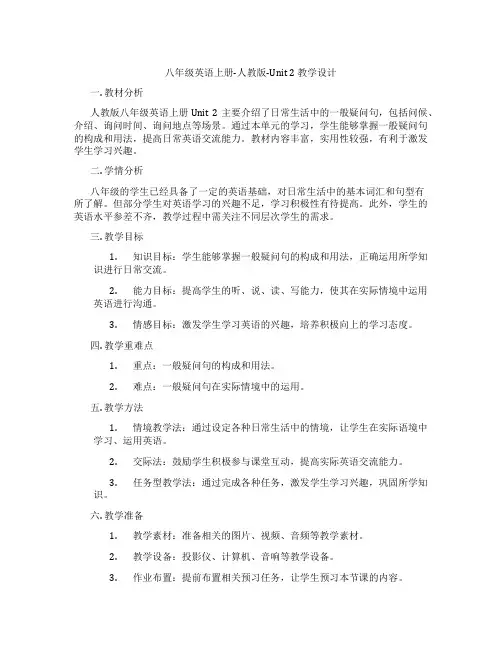
八年级英语上册-人教版-Unit 2 教学设计一. 教材分析人教版八年级英语上册Unit 2主要介绍了日常生活中的一般疑问句,包括问候、介绍、询问时间、询问地点等场景。
通过本单元的学习,学生能够掌握一般疑问句的构成和用法,提高日常英语交流能力。
教材内容丰富,实用性较强,有利于激发学生学习兴趣。
二. 学情分析八年级的学生已经具备了一定的英语基础,对日常生活中的基本词汇和句型有所了解。
但部分学生对英语学习的兴趣不足,学习积极性有待提高。
此外,学生的英语水平参差不齐,教学过程中需关注不同层次学生的需求。
三. 教学目标1.知识目标:学生能够掌握一般疑问句的构成和用法,正确运用所学知识进行日常交流。
2.能力目标:提高学生的听、说、读、写能力,使其在实际情境中运用英语进行沟通。
3.情感目标:激发学生学习英语的兴趣,培养积极向上的学习态度。
四. 教学重难点1.重点:一般疑问句的构成和用法。
2.难点:一般疑问句在实际情境中的运用。
五. 教学方法1.情境教学法:通过设定各种日常生活中的情境,让学生在实际语境中学习、运用英语。
2.交际法:鼓励学生积极参与课堂互动,提高实际英语交流能力。
3.任务型教学法:通过完成各种任务,激发学生学习兴趣,巩固所学知识。
六. 教学准备1.教学素材:准备相关的图片、视频、音频等教学素材。
2.教学设备:投影仪、计算机、音响等教学设备。
3.作业布置:提前布置相关预习任务,让学生预习本节课的内容。
七. 教学过程1.导入(5分钟)利用图片、视频等素材,引入本节课的主题,激发学生学习兴趣。
同时,检查学生对上一节课内容的掌握情况。
2.呈现(10分钟)通过展示图片、实物等,呈现本节课的主要内容,引导学生观察、思考。
同时,用英语介绍一般疑问句的构成和用法。
3.操练(15分钟)将学生分成小组,进行角色扮演,模拟日常生活中的场景,运用一般疑问句进行交流。
教师巡回指导,纠正发音和语法错误。
4.巩固(10分钟)设计一些练习题,让学生填写或回答,巩固对一般疑问句的理解和运用。

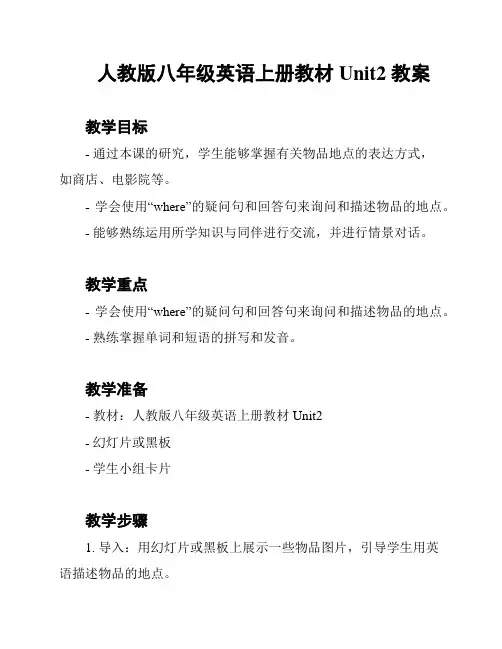
人教版八年级英语上册教材Unit2 教案
教学目标
- 通过本课的研究,学生能够掌握有关物品地点的表达方式,
如商店、电影院等。
- 学会使用“where”的疑问句和回答句来询问和描述物品的地点。
- 能够熟练运用所学知识与同伴进行交流,并进行情景对话。
教学重点
- 学会使用“where”的疑问句和回答句来询问和描述物品的地点。
- 熟练掌握单词和短语的拼写和发音。
教学准备
- 教材:人教版八年级英语上册教材Unit2
- 幻灯片或黑板
- 学生小组卡片
教学步骤
1. 导入:用幻灯片或黑板上展示一些物品图片,引导学生用英
语描述物品的地点。
2. 研究新知:通过教材Unit2的相关内容,教授目标词汇和短语,让学生理解并记忆。
3. 练活动:进行对话练,学生分组,每个小组选择一个物品进行情景对话,询问和回答物品的地点。
4. 拓展活动:让学生运用所学知识,创造自己的对话,交流物品的地点。
5. 归纳总结:让学生回顾所学知识,进行总结归纳。
6. 作业布置:布置课后作业,要求学生练复述本课内容,并使用疑问句和回答句描述物品地点。
教学评价
- 通过学生的课堂表现、练活动和讨论活动来进行评价,检查学生是否能够正确运用所学语言进行物品地点的描述。
- 提供及时的反馈,鼓励学生用英语进行交流。
注意事项
- 确保课堂秩序,引导学生积极参与。
- 注重学生的口语能力培养,鼓励他们进行对话练。
- 提供足够的练机会,让学生熟练掌握所学知识。
以上为人教版八年级英语上册教材Unit2的教案,根据课堂实际情况适当调整教学步骤。
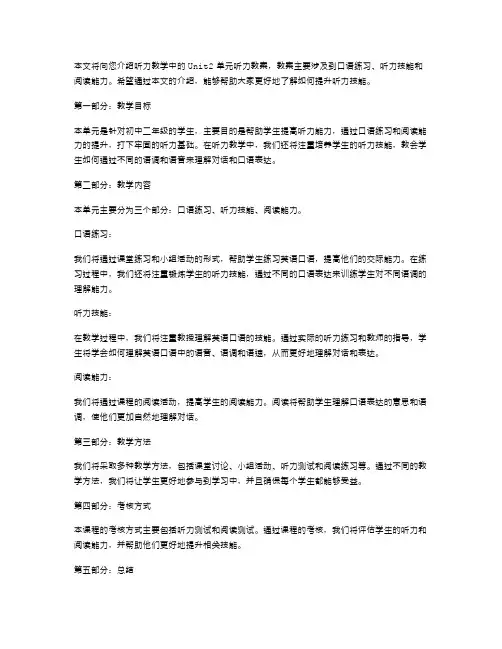
本文将向您介绍听力教学中的Unit2单元听力教案,教案主要涉及到口语练习、听力技能和阅读能力。
希望通过本文的介绍,能够帮助大家更好地了解如何提升听力技能。
第一部分:教学目标本单元是针对初中二年级的学生,主要目的是帮助学生提高听力能力,通过口语练习和阅读能力的提升,打下牢固的听力基础。
在听力教学中,我们还将注重培养学生的听力技能,教会学生如何通过不同的语调和语音来理解对话和口语表达。
第二部分:教学内容本单元主要分为三个部分:口语练习、听力技能、阅读能力。
口语练习:我们将通过课堂练习和小组活动的形式,帮助学生练习英语口语,提高他们的交际能力。
在练习过程中,我们还将注重锻炼学生的听力技能,通过不同的口语表达来训练学生对不同语调的理解能力。
听力技能:在教学过程中,我们将注重教授理解英语口语的技能。
通过实际的听力练习和教师的指导,学生将学会如何理解英语口语中的语音、语调和语速,从而更好地理解对话和表达。
阅读能力:我们将通过课程的阅读活动,提高学生的阅读能力。
阅读将帮助学生理解口语表达的意思和语调,使他们更加自然地理解对话。
第三部分:教学方法我们将采取多种教学方法,包括课堂讨论、小组活动、听力测试和阅读练习等。
通过不同的教学方法,我们将让学生更好地参与到学习中,并且确保每个学生都能够受益。
第四部分:考核方式本课程的考核方式主要包括听力测试和阅读测试。
通过课程的考核,我们将评估学生的听力和阅读能力,并帮助他们更好地提升相关技能。
第五部分:总结通过本单元的学习,学生将更好地理解英语口语,掌握英语语调和语音的技能。
同时,我们还将通过阅读能力的提升,帮助学生更好地理解口语表达的意思和语调。
因此,在接下来的学习中,学生将能够更好地应对英语口语的挑战,从而更加自信地参与到英语学习中去。
八年级英语下册Unit2教案(精选4篇)八年级英语下册Unit2 篇1unit 8 topic 11. 1)so …that …如此…以至于….,that 引导的是结果状语从句,其结构是so +形容词或副词+that 从句。
2)so…that …可以换成such +(a/an)+形容词+名词。
2. would like 作为一个固定结构后接名词,代词,不定式作宾语,也可以用不定式作宾补,表示想要的意思。
1)would like sth. 想要某物;i would like some rice and pork 。
我想要一些米饭和猪肉。
2)would like to do sth. 想要做某事。
3)would like sb. to do sth. 想要某人做某事。
would like = want 想要1. be 为助动词,made 是及物动词make 的过去分词,of 后接宾语,be made of 的主语通常为成品。
be made from 后的原材料则看不出,be made in 主语是成品,介词in 后为产地,be made into 主语为原材料,介词into 后接成品。
the table is made of wood 。
这桌子是由木头制成的。
(可以看出原材料)paper is made from wood 。
纸是由木材制成的。
(看不出原材料)the comb is made in hong kong 。
这把梳子是香港制造的。
iron is made into knives 。
铁可以制成小刀。
2. afford 常接在can ,could ,be able to 之后,意为担负的起(…的费用,损失,后果等);抽的出(时间)。
afford 还有提供,给予,出产的意思。
3. on sale 上市;折价出售,减价出售。
for sale 待售,供出售。
7. (1)though 是从属连词,引导让步状语从句,和连词but 不能连用,但翻译时需译为但是。